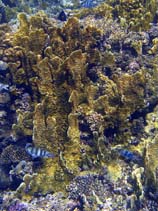Millepora platyphylla Hemprich & Ehrenberg, 1834
Wello fire coralWarning: DOMDocument::load(): SSL operation failed with code 1. OpenSSL Error messages: error:140770FC:SSL routines:SSL23_GET_SERVER_HELLO:unknown protocol in C:\Apache24\htdocs\includes\SpeciesSummary.lib.php on line 1236
Warning: DOMDocument::load(): Failed to enable crypto in C:\Apache24\htdocs\includes\SpeciesSummary.lib.php on line 1236
Warning: DOMDocument::load(https://sealifebase.nrm.se/webservice/AquaMaps/getAMap.php?genus=Millepora&species=platyphylla): failed to open stream: operation failed in C:\Apache24\htdocs\includes\SpeciesSummary.lib.php on line 1236
Warning: DOMDocument::load(): I/O warning : failed to load external entity "https://sealifebase.nrm.se/webservice/AquaMaps/getAMap.php?genus=Millepora&species=platyphylla" in C:\Apache24\htdocs\includes\SpeciesSummary.lib.php on line 1236
Classification / Names Common names | Synonyms | CoL | ITIS | WoRMS
| Anthoathecata | Milleporidae
Environment: milieu / climate zone / depth range / distribution range Écologie
Récifal; profondeur 3 - 6 m (Ref. 8294). Tropical
Distribution Pays | Zones FAO | Écosystèmes | Occurrences | Introductions
Indo-Pacific: West to Red Sea; north to Japan; east to Marquesas; and south to Houtman Abrolhos Islands.
Length at first maturity / Taille / Poids / Âge
Maturity: Lm ? range ? - ? cm Max length : 300 cm WD mâle / non sexé; (Ref. 269); common length : 200 cm WD mâle / non sexé; (Ref. 269)
Description synthétique Morphologie
Forms large colonies, commonly 200 to 300 cm in diameter and composed of anastomosed vertical plates, which may reach 200 cm in height. In life, colonies have a characteristics light brown, color, with white growing edges. If touched, a sharp sting can be felt when coming into contact with soft skin (Ref. 269).
Forms large colonies, commonly 200 to 300 cm in diameter and composed of anastomosed vertical plates, which may reach 200 cm in height (Ref. 269). Depth based from occurrence (Ref. 8294); to be replaced with a better reference. Most common in shallow to intermediate depths (Ref. 269).
Life cycle and mating behavior Maturité | Reproduction | Frai | Œufs | Fécondité | Larves
Members of the order Anthoathecata are mostly colonial A-form hydroids. Life cycle: The zygote develops into planula inside the gonophore and is later released as an actinula which metamorphoses into polyp stage.
Référence principale
Références | Coordinateur | Collaborateurs
Ross, M.A. and G. Hodgson. 1981. (Ref. 8294)
Statut dans la liste rouge de l'IUCN (Ref. 130435)
Least Concern (LC) ; Date assessed: 01 January 2008
statut CITES (Ref. 108899)
Appendix II: International trade monitored
CMS (Ref. 116361)
Not Evaluated
Menace pour l'homme
Utilisations par l'homme
| FishSource |
Outils
Plus d'informations
Pays
Zones FAO
Écosystèmes
Occurrences
Introductions
Stocks
Écologie
Régime alimentaire
Éléments du régime alimentaire
Zones FAO
Écosystèmes
Occurrences
Introductions
Stocks
Écologie
Régime alimentaire
Éléments du régime alimentaire
Sources Internet
BHL | BOLD Systems | CISTI | DiscoverLife | FAO(Publication : search) | Fishipedia | GenBank (genome, nucleotide) | GloBI | Gomexsi | Google Books | Google Scholar | Google | PubMed | Arbre de Vie | Wikipedia (Go, chercher) | Zoological Record
Estimates based on models
Preferred temperature
(Ref. 115969): 24.5 - 29.3, mean 28.4 (based on 3478 cells).
Catégorie de prix
(Ref. 80766):
Unknown.



